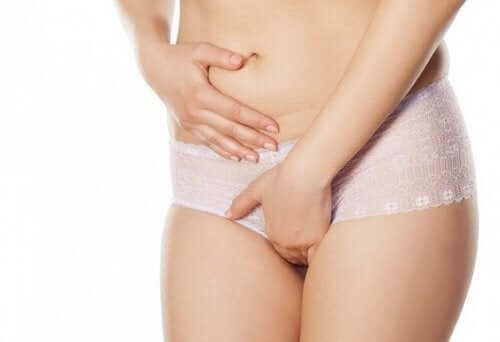Postmenopausal Vaginal Atrophy

Postmenopausal vaginal atrophy appears as a set of symptoms and signs that are associated with decreased estrogen and other sex steroids. It’s a chronic and very common condition during menopause.
It often goes undiagnosed, meaning it can have a major impact on the patient’s sexual health, as well as her quality of life. Experts associate decreased levels of estrogens and other hormones with changes in the labia majora and minora, vaginal introitus, vulval vestibule, clitoris, vagina, urethra, and the bladder.
Estrogen is necessary to maintain vaginal structure and function. In this regard, experts associate decreased levels of these hormones with changes in the physiology of the vagina, which underlie the symptoms that characterize vaginal atrophy.
The symptoms of postmenopausal vaginal atrophy

Postmenopausal vaginal atrophy is a condition that can make women suffer a moderate to acute clinical picture characterized by the following signs and symptoms:
- Vaginal dryness
- Vaginal burning
- Genital itching
- Burning sensation with urination and increased sensation of it
- Pain during sex
- Minor bleeding after sex
- Vaginal narrowing and shortening
However, although vaginal dryness is more common during menopause, this problem can affect women at any stage of their life due to the use of birth control, lactation, postpartum, or peri- and postmenopause. In fact, more than half of the women who suffer from this disorder are under the age of 50.
Risk factors for postmenopausal vaginal atrophy
Certain factors contribute to the development of vaginal atrophy. Some of them are:
- Smoking. Smoking cigarettes affects blood circulation, causing oxygen deficiency in the vagina and other tissues. Also, tobacco reduces the effects of the body’s natural estrogen.
- Not having had natural births. Researchers have deduced that women who’ve never given birth by vaginal delivery are more likely to suffer from this condition than those who have.
- Lack of sexual activity. Sexual activity, with or without a partner, increases blood circulation, and promotes the elasticity of vaginal tissues. Therefore, without it, this condition is more likely to occur.
You may also be interested in reading: How to Cope with Postmenopausal Atrophic Vaginitis
Treatment

The goals of the treatments for postmenopausal vaginal atrophy are to restore the physiology of this body part and relieve symptoms. When the symptoms are mild, first-line treatments include the use of non-hormonal vaginal moisturizers and lubricants during intercourse to improve vaginal dryness, burning, or stinging.
Additionally, moisturizers enrich collagen hydration in the vagina and relieve symptoms. However, they don’t improve the vaginal epithelium.
In moderate or severe cases, experts recommend estrogen treatment. However, if the patient only suffers from vaginal atrophy, the treatment of choice is typically the administration of local estrogen. However, if it appears with vasomotor symptoms that affect the woman’s quality of life, the treatment of choice is often systemic hormonal therapy.
Although it’s very difficult to prevent postmenopausal vaginal atrophy, you can relieve your symptoms as much as possible. You should start by adopting a healthy lifestyle and by eliminating risk factors such as tobacco.
This article may interest you: All About Your Vagina According to Your Age
Other treatments for postmenopausal vaginal atrophy
Besides the measures we mentioned above, other methods can also improve this condition.
For example, there’s laser treatment. This is a minimally invasive technique that uses heat to stimulate the production of collagen in cells of the vaginal area. It replaces the driest skin layers with new cells and reorganizes and balances the components of the vaginal mucosa.
All cited sources were thoroughly reviewed by our team to ensure their quality, reliability, currency, and validity. The bibliography of this article was considered reliable and of academic or scientific accuracy.
- Ernesto Pérez Md Ginecólogo Obstetra, L. A., & Rojas Md, I. C. (2011). Menopausia: panorama actual de manejo M. rev. fac. med.
- D. W. Sturdee, & Panay, N. (2010). Recomendaciones para el manejo de la atrofia vaginal postmenopáusica. International Menopause Society.
- Palacios, S., Jesús Cancelo, M., Castelo-Branco, C., González, S., & Olalla, M. Á. (2012). Recomendaciones de la Sociedad Española de Ginecología y Obstetricia sobre la prevención y el tratamiento de la atrofia vaginal. Progresos de Obstetricia y Ginecologia. https://doi.org/10.1016/j.pog.2012.06.001
This text is provided for informational purposes only and does not replace consultation with a professional. If in doubt, consult your specialist.








